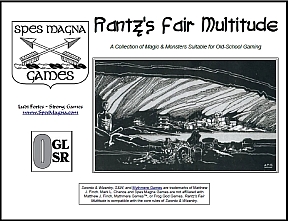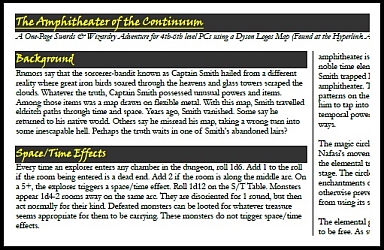
Ever hang out with a child that has learned that he too can say, “No!”? Delightful, isn’t he? Ever play with a GM that has the same propensity? Fun, huh?
Fortunately, most GMs, like most children, outgrow the “No!” stage. Those that don’t, GMs and children, end up being rather unpleasant as adults, which has its own consequences, such as a lack of players (for GMs) or a lack of friends (for adults in general). Oh, sure, there’re probably players who tolerate Negative GMs, but probably more out of a wrong-headed sense of gamer solidarity than a genuine desire to put up with such nonsense.
I’ve encountered Negative GMs a few times over the years. How about some examples to better illustrate what I’m talking about?
Example the First
Many years ago, I was playing in a Forgotten Realms adventure. The GM described how monsters approached rapidly from a distance, obviously intending to attack us.
“How far away are they?” asked a player.
“Do you have the Estimate Distance nonweapon proficiency?” asked the GM.
None of us had that nonweapon proficiency. I’m pretty sure none of us even knew there was such a nonweapon proficiency.
“No, you can’t tell how far away the monsters are,” the GM said.
Example the Second
Even more years ago, I was playing a 1E game, running my paladin Karras the Damned. We were defending a fort from a horde of evil humanoids, ogres, and giants. We were seriously outclassed, but at least we had the advantage of the fort’s defenses. Even still, the horde eventually battered down the gates and flooded into the yard.
“Karras ducks into that narrow hall and attacks the hill giant after it passes him,” I said.
“No,” said the GM.
“Huh?”
“You’re a paladin. You can’t attack by surprise.”
Example the Third
Just to show that the problem isn’t always the GM, I offer up an example of the Negative Player. I was running a D&D game. The PCs were fighting a pitched battle on the topmost storey of a large tower. Flying monsters were setting fire to the roof over their heads.
“My character wants to get out onto the roof to fight the flying monsters,” said a player.
“Okay,” said I. “How?”
“Um, he could lean out a window, swing his rope and grappling hook up, and try to latch onto the roof. Then, he could climb up.”
“No,” said the Negative Player. “That won’t work.”
“Really?” said I. “How come?”
The Negative Player launched into a pedantic monologue about gravity, arcs, and roofing materials. I felt sorry for asking.
Jim Butcher Weighs In
At the last Space City Con here in Houston, Texas, author Jim Butcher offered a couple of sessions about writing. When deciding the outcome of a conflict in a story, Mr. Butcher opined that there are only four options available to the writer:
1. Yes
2. Yes, But
3. No
4. No, and Furthermore
Since roleplaying games are a form of shared storytelling, it stands to reason that these four options ought to be available to GMs and the other players. Notice how the possibility of three options other than “No!” could apply to each situation above. For example, in the first example, the GM could’ve said, “Yes, you can estimate the distance to the monsters, but your estimation won’t be as accurate as if you had the Estimate Distance nonweapon proficiency.”
So, you might be wondering, what’s the point, Mark?
Skill Checks for Swords & Wizardry
I like Swords & Wizardry. I also like systems for resolving skill checks, such as determining if a PC can jump across a chasm, identify a monster by its tracks, or repair a suit of armor. On the other hand, I don’t like skill lists. Lists, by their very nature, limit options because no list can account for every possibility. The list’s limitations may end up being the PC’s limitations as well (“Sorry, you can’t tell how far away something is because you don’t have the right skill.”).
On the same other hand, I don’t like skill systems that melt a class’s special snowflakeness. Thieves get to be sneaky, pick locks, and find traps. A skill system that lets other classes do those things steps on thieves’ toes. But, that doesn’t mean a fighter or a wizard can’t be sneaky. A GM ought not simply declare, “Your fighter cannot hide in the shadows or move quietly. Those are thief abilities, and fighters don’t have thief abilities.”
Ergo, what I want for Swords & Wizardry is a skill system that:
1. Doesn’t involve skill lists
2. Doesn’t melt special snowflakes
3. Doesn’t say “No!” as the default answer
4. Doesn’t require modifying Swords & Wizardry any more than minimally necessary
Swords & Wizardry, Meet Barbarians of Lemuria
BoL uses a single dice mechanic for all action resolution. For skill-type checks, the player rolls 2d6 + the PC’s relevant ability score + the PC’s relevant career ranks. Any result of 9 or higher is a success. For example, a PC wants to appraise a gem. The player rolls 2d6 and adds the PC’s Mind and merchant career ranks. (BoL includes possibilities for really bad failures as well as really good successes, but I’m not worried about critical results at the moment.)
A PC may also have boons or flaws. These present situations in which a PC is particularly good or noticeably bad at certain tasks. Either way, the player rolls 3d6 instead of 2d6. For a boon, the player picks the two best dice. For a flaw, he picks the two worst dice. Everything else stays the same.
In order start grafting this sort of system onto Swords & Wizardry, it seems as if I need some careers, a dice mechanic (I’m leaning toward 2d10 with a target number of 15+), and perhaps some sort of boon/flaw mechanic. I’ve got some basic ideas, but I need to put some more thought into them before I take this concept any further.
Until then, good gaming!
Tags: Barbarians of Lemuria, game play, Swords & Wizardry




